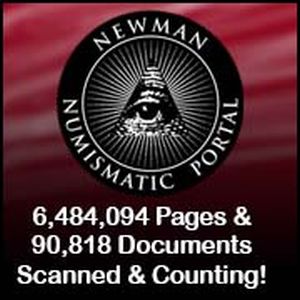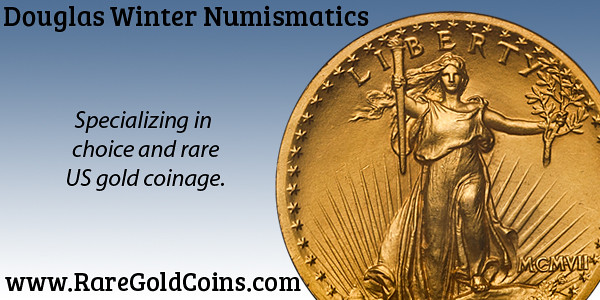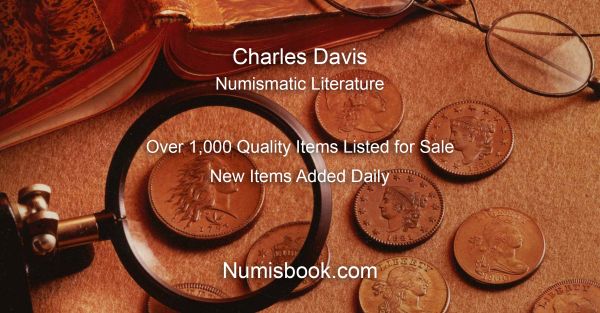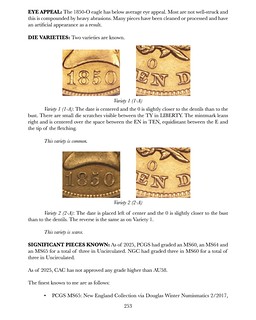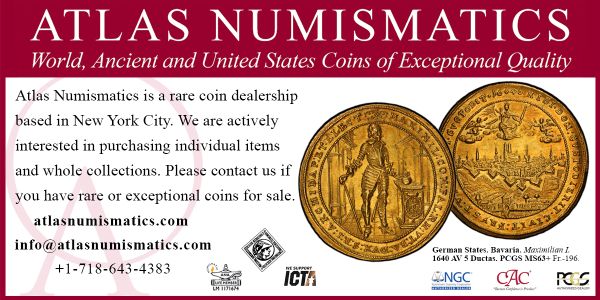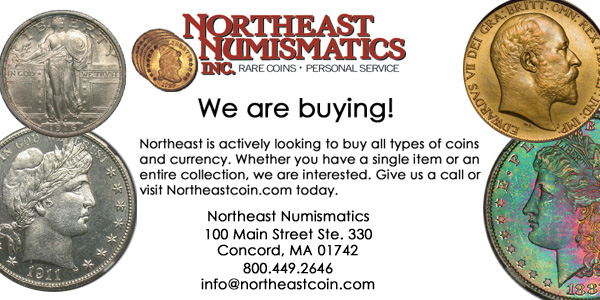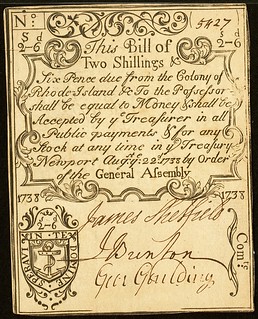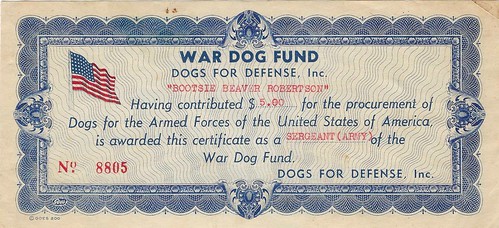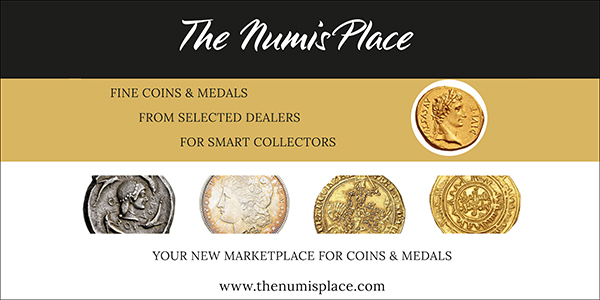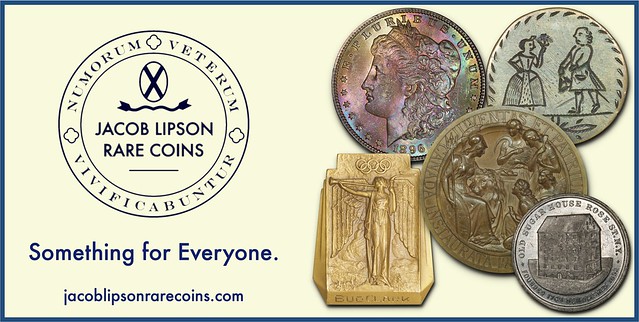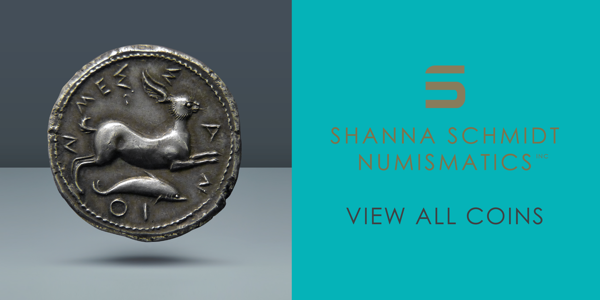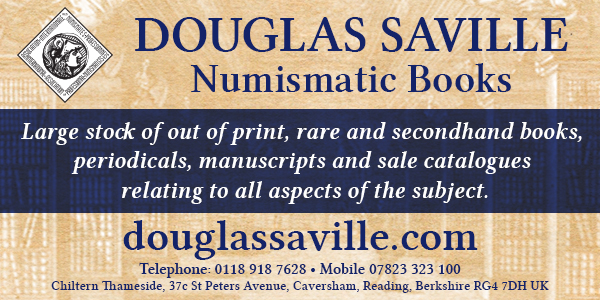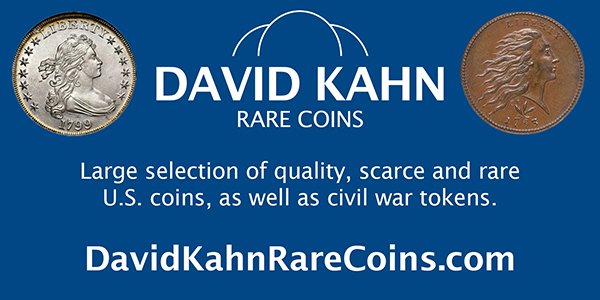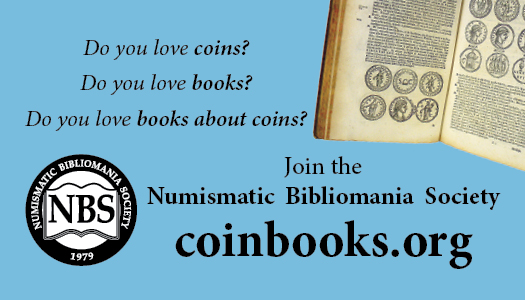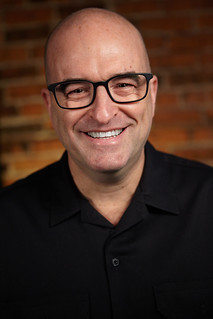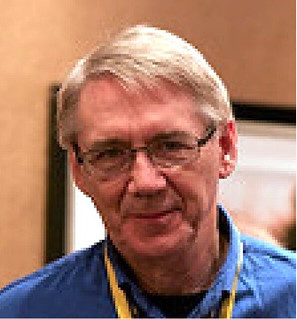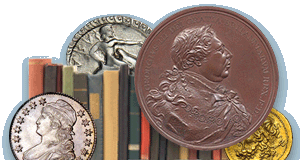
Visit our NBS Sponsors
About UsThe Numismatic Bibliomania Society is a non-profit association devoted to the study and enjoyment of numismatic literature. For more information please see our web site at coinbooks.org SubscriptionsThose wishing to become new E-Sylum subscribers can go to the following web page Subscribe MembershipThere is a membership application available on the web site Membership Application To join, print the application and return it with your check to the address printed on the application. Print/Digital membership is $40 to addresses in the U.S., and $60 elsewhere. A digital-only membership is available for $25. For those without web access, write to: Jeff Dickerson, Treasurer AsylumFor Asylum mailing address changes and other membership questions, contact Jeff at this email address: treasurer@coinbooks.org SubmissionsTo submit items for publication in The E-Sylum, write to the Editor at this address: whomren@gmail.com BUY THE BOOK BEFORE THE COINSale CalendarWatch here for updates! |
- WAYNE'S WORDS: THE E-SYLUM AUGUST 10, 2025
- NBS BIBLIOTALK PODCAST WITH JOHN FEIGENBAUM
- NBS EVENTS AT 2025 ANA WORLD'S FAIR OF MONEY
- NEW BOOK: GOLD COINS OF NEW ORLEANS MINT 5TH ED.
- PERIODICAL: CONDER TOKEN JOURNAL SUMMER 2025
- MORE NNP U.S. COIN PHOTO FILES
- VIDEO: LOUIS BRAILLE COMMEMORATIVE COIN
- ANA LITERARY AWARDS ANNOUNCED
- ANA YN LITERARY AWARDS ANNOUNCED
- 2025 OKLAHOMA ANA ONLINE EXHIBIT GUIDE
- MORE ON DAVID MACDONALD
- NOTES FROM E-SYLUM READERS: AUGUST 10, 2025
- JEFF GARRETT VISITS THE OSBORNE MINT
- VOCABULARY TERMS: RIM BREAK, RIM DIEBREAK
- AUTHORS ON COINS AND MEDALS
- TREASURE TALK WITH BOB EVANS, EPISODE 7.1
- THE SAN FRANCISCO MINT IN 1913
- NUMISMAGRAM MEDAL SELECTIONS: AUGUST 10, 2025
- HERITAGE AUCTIONS: BYZANTINE COINS SHOWCASE
- GADOURY BLEU: ISLAM, POPES, GOLD AND FRANCE
- ABOUT THIS ISSUE: AUGUST 10, 2025
Content presented in The E-Sylum is not necessarily researched or independently fact-checked, and views expressed do not necessarily represent those of the Numismatic Bibliomania Society.
WAYNE'S WORDS: THE E-SYLUM AUGUST 10, 2025
 Thank you for reading The E-Sylum. If you enjoy it, please send me the email addresses of friends you think may enjoy it as well and I'll send them a subscription. Contact me at whomren@gmail.com anytime regarding your subscription, or questions, comments or suggestions about our content.
Thank you for reading The E-Sylum. If you enjoy it, please send me the email addresses of friends you think may enjoy it as well and I'll send them a subscription. Contact me at whomren@gmail.com anytime regarding your subscription, or questions, comments or suggestions about our content.
With this week's issue we're switching over to MailChimp as our email provider. Thanks to Rob Luton for helping verify that Monday's test worked. Some of you may have been inactive for some reason on our old mailing list, so this may be the first email you've gotten from us in a while. Some of you were subscribers under an old digest or text-only format, and may be seeing our email in its full normal form for the first time. Welcome, and let me know at the above email address if you have any questions or problems. There should be an Unsubscribe link at the bottom if you'd rather opt out, and above this article are subscribe/unsubscribe links people can use anytime. Thanks again for your patience during this upgrade.
This week we open with two NBS updates, a new book. one periodical, updates from the Newman Numismatic Portal and the ANA, and more.
Other topics this week include Whitman Brands, New Orleans Mint gold coins, numismatic literature exhibits at the upcoming ANA, David Macdonald, the Osborne Mint, rim breaks, authors on coins and medals, and fixed price and auction offerings.
To learn more about Conder tokens, the "death of print", the NBS Charity Auction, the "the Fairmont Effect", Hard Times Tokens, Louis Braille, "Building Canals with Paper", OPA Red Points and Blue Points, Fractional Currency literature, the War Dog Fund, the finest known 1857-S $3 gold piece, and How to Raise Pigs with Little Money, read on. Have a great week, everyone!
Wayne Homren
Editor, The E-Sylum
NBS BIBLIOTALK PODCAST WITH JOHN FEIGENBAUM
The latest episode of the Numismatic Bibliomania Society podcast is now available for listening. It's on the NBS web site but also available elsewhere. President Len Augsburger provided this report. -Editor
NBS Podcast Interviews John Feigenbaum
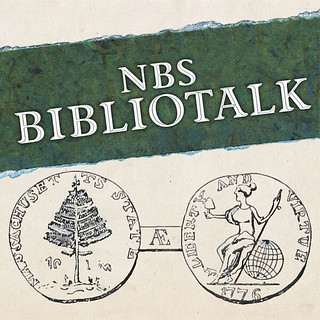 In the latest NBS podcast, Lianna Spurrier interviews John Feigenbaum, CEO of CDN and Whitman Brands. John grew up in the business, with a father who started as a weekend dealer and eventually took up numismatics full time. David Feigenbaum and son built up David Lawrence Rare Coins, which was eventually sold to John Brush and Dell Loy Hansen in 2018.
In the latest NBS podcast, Lianna Spurrier interviews John Feigenbaum, CEO of CDN and Whitman Brands. John grew up in the business, with a father who started as a weekend dealer and eventually took up numismatics full time. David Feigenbaum and son built up David Lawrence Rare Coins, which was eventually sold to John Brush and Dell Loy Hansen in 2018.
John covers the ever ubiquitous Guide Book of U.S. Coins, one of the best-selling books of all time of any genre, and discusses the past and future evolution of this standard guide. Feigenbaum opines on the importance of keeping this resource in numismatic hands, as opposed to a mass market publisher. Finally, John has an interesting take on the "death of print" and shares good news for all book lovers!
I gave it a play on Spotify during my Friday evening commute, and it's well worth a listen. Len's description is a good one, and I would add that it only reinforces my thought that John and his team are ideal stewards of Whitman, carrying its central hobby publishing legacy into the future. I'm looking forward to their new editions and titles.
I've had my own hand in moving to the future working with the Newman Numismatic Portal, but people need reminding that no, not everything is available on the internet for free, nor should it be. I have several bookcases of numismatic titles here in my office, and except for a handful, most are in-copyright and not available except in book form or by online subscription. The good people who research, compile, write and publish these works need to be compensated, and 240,000 purchasers of the latest Redbook agree. The hobby is alive and well. -Editor
Link to "Inside Whitman Brands Part 2, with John Feigenbaum" on the NBS website:
https://www.coinbooks.org/resources/podcast.html
NBS EVENTS AT 2025 ANA WORLD'S FAIR OF MONEY
The American Numismatic Association's annual summer event is nearly upon us. Our sponsor, the Numismatic Bibliomania Society, has several events planned that are open to all, and we hope to see good number of NBS members and E-Sylum readers in attendance at the Oklahoma City Convention Center. Throughout the show please stop by the club table anytime to chat with NBS officers and fellow numismatic bibliophiles. -Editor
Thursday, August 21 at 1:00PM (Room 106)
 Jeff Garrett
Jeff Garrett
speaks on the Guide Book of U.S. Coins
One of the best-selling books of all time of any genre, the ubiquitous "Red Book" has been informing U.S. coin collectors since the first edition was published in 1947.
Now in its 78th edition, the Guide Book of U.S. Coins has become collectible itself, with the earliest editions especially prized. Jeff Garrett, Guide Book Senior Editor, will speak on the challenges of keeping this foundational reference accessible and authoritative at the same time.
 Len Augsburger
Len Augsburger
speaks on the 1992 M. N. Daycius Caper
In 1992, American bibliophiles received a one-page flyer in the mail that advertised a numismatic literature sale to be held April 1, 1992 in Fort Worth, TX, at "1204 Magnolia," which just happened to be the former address of the coin dealer B. Max Mehl. The announcement hinted the material was of great value and that the cataloger was not completely familiar with the significance of the items.
Since 1992, the identity of the hoaxster has been the subject of much speculation. Recently, new information has come to light that finally identifies the perpetrator of the "M. N. Daycius Caper." This came to us completely unsolicited, and not in response to any investigation on our part. All shall be revealed at the NBS Symposium.
Friday, August 22 at 11:30AM (Room 203)
Each year at the ANA World's Fair of Money, the Numismatic Bibliomania Society conducts a charity auction to raise funds for the organization. All items sold are donated to the NBS by members and 100% of the proceeds go to the NBS treasury.
Absentee bids due by close of day Thursday, August 21
Absentee bids should be sent to David Fanning at
df@numislit.com by the end of Thursday, August 21.
The sale will take place on Friday, August 22 as part of the NBS General Meeting, to be held in Room 203 from 11:30 a.m. to 1:30 p.m. Please read the terms of sale before bidding.
Thank you for your support of the NBS!
To see the Benefit Auction Catalogue:
https://mcusercontent.com/5c68a72f4948c463818f613c2/files/38ae55da-f801-cff7-5491-0b20cda9d35c/NBS_Auction.pdf
The Winter 2025 issue of The Asylum will be a tribute issue to NBS co-founder George Frederick Kolbe. Please send any remembrances or photographs (especially older ones) to editor Maria Fanning at
asylum@coinbooks.org by November 1, 2025.
Email your photos and stories from the ANA World's Fair of Money to asylum@coinbooks.org by September 1 for inclusion in our next issue.
NEW BOOK: GOLD COINS OF NEW ORLEANS MINT 5TH ED.
Author and longtime E-Sylum supporter Doug Winter has published a new edition of his book on New Orleans Mint gold. Here's the announcement. -Editor
Fifth Edition, 2025
DWN Publishing, a division of Douglas Winter Numismatics, is pleased to announce the fifth edition of its popular title, Gold Coins of the New Orleans Mint, 1839-1909. Pre-orders for this hardcover 407 page reference are being accepted in early August, 2025 and the cost is $150 which includes shipping.
The last edition of this work was published in 2020 and, according to Doug Winter, "the market for New Orleans gold—especially for half eagles, eagles, and double eagles—has changed radically due to the infusion of hundreds of high(er) grade coins sourced from the Fairmont Hoard. A number of these coins qualify as being in the Condition Census for their respective issues and in the new fifth edition, every one of these is noted. These coins changed the total number known for many issues and the rarity rankings for a number of New Orleans half eagles and eagles were also changed."
For each half eagle, No Motto eagle and double eagle, the new edition has a summary called "the Fairmont Effect" which gives the total number of coins graded by PCGS for each issue as well as the number of coins approved by CAC. This information is valuable and it can be found nowhere else. Also included are the APR's for the single finest graded of each issue. Additionally, for many issues the impact on prices by the Fairmont coins is noted and analyzed by Winter.
Many students of New Orleans gold coinage will have special interest in the 30 page chapter written by DWN Research Associate Richard Radick entitled "The Fairmont Coins from New Orleans." Radick does a deep dive into the nuts and bolts of the almost 8,300 US gold coins graded by PCGS which bear the pedigree "Fairmont Collection" on the inserts of their holders. This remarkable study contains lots of valuable information which is not available anywhere else.
The book contains dozens of full color images of high-grade New Orleans gold coins; many from the New England Collection which is the finest complete set of gold coins ever assembled from this mint.
A sample copy of the book will be available at the DWN table (#817) at the upcoming Summer ANA convention in Oklahoma City. Copies are being printed as you read this email, and we anticipate shipping to you in early September.
We accept checks or money orders made out to Douglas Winter Numismatics, and mailed to PO Box 4383, Portland OR 97208.
As always, you can contact me directly at dwn@ont.com, or by phone at 214.675.9897. I look forward to hearing from you.
For more information, or to order, see:
https://raregoldcoins.com/
PERIODICAL: CONDER TOKEN JOURNAL SUMMER 2025
The Summer 2025 issue of The "Conder" Token Collector's Journal has been published by the Conder Token Collector's Club. The group focuses on the 18th Century British/Irish tokens cataloged by James Conder. -Editor
Note from our President
Jeff Rock
After He's Gone
William Frank
I Need an Edge
Jon Lusk
Lancashire 138 Bis III Reappears!
Jeff Rock & Gordon Greenman
Collecting Handel
Chriss Hoffman
Oct. 2024, A Double Dose Of Auctions
Jeff Rock
The Token Exchange and Mart
For more information on the Conder Token Collector's Club, see:
https://ctcc.info/
MORE NNP U.S. COIN PHOTO FILES
The latest additions to the Newman Numismatic Portal are photo files contributed by Saul Teichman. Project Coordinator Len Augsburger provided the following report. -Editor
Saul Teichman Adds U.S. Coin Photo Files to Newman Portal
Saul Teichman continues to build condition censes of significant U.S. coins, with the most extensive work being done in the pattern series. Saul recently contributed a file on the Low 54-A Hard Times token, the well-known AM I NOT A MAN AND BROTHER anti-slavery piece. Until 2011 only three examples were known, from the Ford, Newman, and Partrick collections. The fourth piece was discovered in Canada and has since been offered by both Stack's and Heritage.
Eric P. Newman recounted his research work on the AM I NOT A MAN AND BROTHER token in the video "Promotion and Suppression of Hard Times Tokens," from the 1989 ANA convention. The work required extensive examination of the anti-slavery newspapers, many of a religious bent. "I read so many of them I nearly turned fundamentalist," Newman recalled.
Image: Low-54A, from the Newman collection (Heritage June 2016, lot 98196, realized $70,500).
Link to Teichman U.S. Patterns photo files:
https://nnp.wustl.edu/library/archivedetail/548148
Link to Teichman U.S. Rarities photo files:
https://nnp.wustl.edu/library/archivedetail/556362
Link to Teichman U.S. Colonial coinage photo files:
https://nnp.wustl.edu/library/archivedetail/556767
Link to Teichman U.S. Error coinage photo files:
https://nnp.wustl.edu/library/archivedetail/556461
Link to Teichman U.S. Medals & Tokens photo files:
https://nnp.wustl.edu/library/archivedetail/556768
Link to Teichman U.S. Territorial gold photo files:
https://nnp.wustl.edu/library/archivedetail/554268
Link to Eric P. Newman lecture on the Low-54A:
https://www.youtube.com/watch?v=diP_EsNWcPM
VIDEO: LOUIS BRAILLE COMMEMORATIVE COIN
The David Lisot Video Library on the Newman Numismatic Portal can be found at:
https://nnp.wustl.edu/library/multimediadetail/522852
We highlight one of his videos each week in The E-Sylum. Here's one from 2009 about the Louis Braille Commemorative. -Editor
This is the story of the new coin for the man who created a system for the blind to be able to read. Speaker: John Pare.
And there's another coin depicting books. See Pete Smith's article elsewhere in this issue. -Editor
To watch the complete video, see:
New Commemorative Coin Celebrating Louis Braille
(https://youtu.be/5C2hSZbybCs)
New Commemorative Coin Celebrating Louis Braille
(https://nnp.wustl.edu/library/book/549144)
ANA LITERARY AWARDS ANNOUNCED
The ANA has announced the recipients of its 2025 literary awards. -Garrett
The American Numismatic Association's (ANA) 2025 literary awards – recognizing articles published in the 2024 volume of its official magazine, The Numismatist – will be presented during the Member Awards and Donor Celebration at the Oklahoma City World's Fair of Money® on August 21. The Numismatist was launched by ANA founder and first editor Dr. George F. Heath in 1888. This year marks its 138th volume.
The Heath Literary Award, introduced in 1949, acknowledges outstanding articles published in the preceding 12 months.
- First place goes to David Schenkman for "Take Me Out to the Ball Game" (March 2024). The author will receive $250, an engraved nickel-silver medal, and a certificate.
- William R. Eckberg earned second place ($100, an engraved bronze medal, and a certificate) for "The Birch Cent" (June 2024).
- In third place (engraved bronze medal and a certificate) is Alex Schultz for "The 1964 Special Mint Sets: Special or Not?" (November 2024).
The Wayte and Olga Raymond Memorial Literary Award, endowed in 1978 by the late John J. Ford Jr., is presented for articles that display original and comprehensive research in U.S. numismatics.
- William R. Eckberg received first place ($400 and a certificate) for "The Birch Cent" (June 2024).
- Second place ($200 and certificate) goes to R.W. Julian for "The 1836 Gobrecht Dollar" (December 2024).
- Eckberg also received third place (certificate) for "Robert Scot's Signature" (September 2024).
Founded by an anonymous donor, the Catherine Sheehan Literary Award for Paper Money Studies includes $50 and a certificate for first place.
- David Schenkman took the top prize for "Building Canals with Paper" (June 2024).
- Second place (certificate) goes to Kenneth Bressett for "The Shot Heard 'Round the World" (July 2024).
- Ray Muniak received third place (certificate) for "Wartime Memento" (May 2024).
The Prue and Arthur Fitts Literary Award for Ancient and Medieval Coinage Studies recognizes literary excellence in those fields.
- Michael Shutterly received first place ($250 and a plaque) for "Medieval Salutes to Mary" (April 2024).
- Earning second place (certificate) is Bruce Bartelt for "Nero & the Ancient Games" (August 2024).
- Donald H. Kagin received third place (certificate) for "St. Eligius: A Numismatic Saint" (December 2024).
Honorable mentions for this year include "The Finest in the Country" by Pete Smith (September 2024) and "Congress and U.S. Currency, Parts 1 & 2" by William Cather (March and April 2024).
All feature articles published in The Numismatist automatically are considered for the Heath Literary Award; likewise, all qualifying articles are evaluated for the Raymond, Sheehan, and Fitts Awards. For information about submitting manuscripts for review and possible publication, visit money.org/the-numismatist/submission-guidelines.
ANA YN LITERARY AWARDS ANNOUNCED
The ANA has announced the recipients of its 2025 Young Numismatist (YN) Literary Awards. -Garrett
The 2025 ANA Young Numismatist (YN) Literary Awards were announced during the ANA's annual Summer Seminar banquets. The three award categories are generously funded by Whitman Publishing and named after authors dedicated to educating the next generation of numismatists.
The Bill Fivaz Young Numismatist Literary Award honors writers who are aged 8 to 12. This year's first place recipient was Daniel Kim for "The Art and Science of Coins: History in Coins." Harrison Bluhm received second place with "Understanding OPA Red Points and Blue Points: A Deep Dive into Their Roles and Impact." In third place was John Swindling for "Lionel Mint Cars: A Numismatic Side Quest."
The Q. David Bowers Young Numismatist Literary Award honors writers who are aged 13 to 17. This year's first place recipient was Jackson R. Hancock for "The Sun Never Sets on British Colonial Currency." Aman Ryan Shah placed second with "A Circulation Secret" and Nate Leonauskas took third with his paper "Past the Piece of Eight."
The Kenneth E. Bressett Young Numismatist Literary Award is given to writers between the ages of 18 and 22. This year, first place was won by Eva Pate for "The Significance of Sarah Sophia Banks." Second place was awarded to JP Coogan for "An Examination of Indian Peace Medals in the United States." Jason Rackas received third place for "The British 50 Pence Coin."
The first-place winners received a $500 cash prize, plus a $500 voucher with which to build a personal library of numismatic books produced by Whitman Publishing. Second- and third-place winners received book vouchers for $200 and $100, respectively. To learn more about this program, visit money.org/american-numismatic-association-awards.
2025 OKLAHOMA ANA ONLINE EXHIBIT GUIDE
Paul Hybert submitted this note about the exhibits at the upcoming American Numismatic Association World's Fair of Money in Oklahoma City, Oklahoma. -Editor
An online guide to the Collector Exhibit Area at the August 19-23 World's Fair of Money is available at: http://www.chicagocoinclub.org/events/2025/ana/ex/all_by_cl.html
The Collector Exhibits are no longer listed in the Show Guide. The above guide groups the exhibits by Exhibit Class, while the ANA website has an ungrouped listing of exhibits at: https://www.money.org/wfm-exhibits/
 Visit a page before you arrive at the convention center to determine
your must-see exhibits, or visit this page to help you remember that
exhibit you want to see again! The online guide will be updated during
the convention, to list just the exhibits which are present, and to
reflect if an exhibit has been changed to a different Class.
Visit a page before you arrive at the convention center to determine
your must-see exhibits, or visit this page to help you remember that
exhibit you want to see again! The online guide will be updated during
the convention, to list just the exhibits which are present, and to
reflect if an exhibit has been changed to a different Class.
There are four exhibits in the Numismatic Literature class. We expect 52 exhibits covering a wide range of material. Look for your favorite topics, or look for something new to collect.
For this WFoM, the Collector Exhibit Area is located in the back of bourse hall (near the club tables), so you need to enter the bourse before you can visit the Collector Exhibit Area. On Wednesday through Saturday mornings, you can enter the Collector Exhibit Area as soon as you can enter the bourse hall. Refer to the schedule for the staggered opening times for: dealers, ANA members, and the public.
Check out the listings - looks like a great set of exhibits. For bibliophiles, here are the entrants in the Numismatic literature class. -Editor
Who Is Charles Steigerwalt?
The exhibit discusses Mr. Steigerwalt's life from his childhood to his tragic death. You will learn he was not only an auctioneer but also a coin dealer, publisher, and collector of many articles. He would become one of the foremost numismatists of his time. Even today, Mr. Steigerwalt is still referred to in coin auction catalogs and other numismatic publications.
The 1804 Large Cent
The 1804 Large Cent has fascinated numismatists for over 200 years. From the advent of American coin collecting and continuing into the present day, it has been viewed as one of the key dates to the series, and one of the rarest cents issued in the 233-year history of the denomination. With that background, it has also become one of the most studied issues. Here, I will take a look at some of the research into this exciting coin using materials from Walter Breen and R.W. Julian, as well as a pair of coins: one 1804 original and one "restrike."
Fractional Currency Literature
To showcase some of the different reference books, dealer fixed price lists, articles, and auction catalogs related mainly to fractional currency. It will include books with heavy fractional currency information that is not the main purpose of the book.
Auction Catalogues Featuring the 1804 Dollar
Display all auction catalogues from 1867 to 2021 that feature an original 1804 silver dollar. Each catalogue will be described with additional information on: the dealer, rarity of the catalogue, and other pertinent information on the 1804 dollar (specimen, sale price, etc.).
MORE ON DAVID MACDONALD
Dennis Tucker adds these thoughts about author David MacDonald. Thank you. -Editor
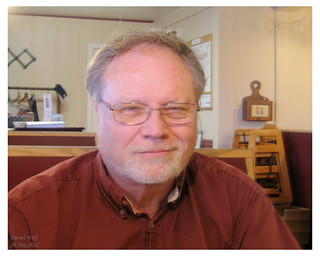 I remember my conversations with David MacDonald in late 2006 and early 2007. He had recently retired from 34 years of teaching in the History department of Illinois State University, and he had a new book idea. It would be a study in Greek chronology and monetary theory as told through overstruck Greek coins. "Can you give me a brief analysis of current competition?" I asked. "There are no similar books," was Mac's reply. (There were some narrowly specialized articles about individual overstruck Greek coins, or related groups of coins, published in foreign journals.) That made my next question moot --- "How would your book be superior to others in the same field?" There were no others in the field!
I remember my conversations with David MacDonald in late 2006 and early 2007. He had recently retired from 34 years of teaching in the History department of Illinois State University, and he had a new book idea. It would be a study in Greek chronology and monetary theory as told through overstruck Greek coins. "Can you give me a brief analysis of current competition?" I asked. "There are no similar books," was Mac's reply. (There were some narrowly specialized articles about individual overstruck Greek coins, or related groups of coins, published in foreign journals.) That made my next question moot --- "How would your book be superior to others in the same field?" There were no others in the field!
Whitman Publishing already had several books about ancient coins in its back list. There was the Handbook of Ancient Greek and Roman Coins, a very popular volume that combined two earlier works by Zander Klawans (skillfully edited together by Kenneth Bressett); Money of the Bible (authored by Bressett); Coins of the Bible (by Arthur Friedberg); and 100 Greatest Ancient Coins (by Harlan J. Berk). Ancient coins were also discussed in chapters or sections of other Whitman books. MacDonald's study would be a more specialized exploration of the subject, intended for serious numismatists, but intriguing enough to appeal to general collectors and historians.
 We had a few more conversations, and in March 2007 signed a publishing agreement for what would become his book Overstruck Greek Coins. It was published in September 2009. We submitted the book in the 2010 Writers' Competition of the Numismatic Literary Guild. Mac wasn't able to make it to Boston for the annual American Numismatic Association World's Fair of Money, where the NLG held its awards banquet. Overstruck Greek Coins earned the prize for "Best Specialized Book on World Coins." I was honored to accept the award on his behalf.
We had a few more conversations, and in March 2007 signed a publishing agreement for what would become his book Overstruck Greek Coins. It was published in September 2009. We submitted the book in the 2010 Writers' Competition of the Numismatic Literary Guild. Mac wasn't able to make it to Boston for the annual American Numismatic Association World's Fair of Money, where the NLG held its awards banquet. Overstruck Greek Coins earned the prize for "Best Specialized Book on World Coins." I was honored to accept the award on his behalf.
David MacDonald's sterling reputation in the field of history was well deserved. He inspired his students and colleagues. No less an ancient-world authority than Harlan J. Berk said of Overstruck Greek Coins, "The sophistication of ancient cultures in monetary terms was revealed to me by this remarkable volume." Mac touched a lot of lives and encouraged many people to dig deeper in their studies. I'm grateful to have been part of his life as a published and celebrated author.
 To read the earlier E-Sylum articles, see:
To read the earlier E-Sylum articles, see:
NEW BOOK: OVERSTRUCK GREEK COINS BY DAVID MACDONALD
(https://www.coinbooks.org/esylum_v12n34a03.html)
BOOK REVIEW: OVERSTRUCK GREEK COINS BY DAVID MACDONALD
(https://www.coinbooks.org/esylum_v12n41a05.html)
DAVID JOHN MACDONALD (1943–2025)
(https://www.coinbooks.org/v28/
esylum_v28n28a05.html)
NOTES FROM E-SYLUM READERS: AUGUST 10, 2025
1738 Rhode Island Rarity Repro
Regarding the 1738 Rhode Island note discussed last week,
David Gladfelter writes:
"While it is true that this genuine 18th century issued bill of credit is a rarity, and it is also true that the plates from which it was printed still exist. However, because the plates were used to make reprints at an unknown later date, it is possible to obtain an inexpensive reprint printed from the same actual plates as the rare originals.
"The late Eric P. Newman, in the current edition of his treatise The Early Paper Money of America, states that six denominations of low-value bills with the issue date August 22, 1738, were printed by William Clagett from a single face plate and a matching single back plate, both engraved by him. The denominations are 1s, 2s6d, 3s, 5s, 7s6d and 10s. Both originals and reprints would have been printed as 6-subject sheets of bills and then cut up. I'm not aware that any of the bills exist today in sheet form. Mine is the 7s6d value which has an untrimmed right margin, placing it on the left side of the plate which was engraved in mirror image. Each bill is surrounded by a single-line frame which is placed within a heavy-line skeleton structure. You can see parts of both lines on the Stack's-Bowers example."
Thanks. Above is the genuine 2s6d note and images of the 7s6d reproduction. Thanks. -Editor
David adds:
"Notice that they are on separate pieces of paper – that's the way that the unknown printer made them. The face plate repro has the selvage margin at the right, making it possible to place that image on the left side of the printing plate. At that margin, you can also see the thin subject frame and the thicker skeleton-structure that I mentioned."
To read the earlier E-Sylum article, see:
1738 RHODE ISLAND RARITY
(https://www.coinbooks.org/v28/esylum_v28n31a24.html)
Coin Envelope Provenance Sought
Clark Davis writes:
"Recently, I have been researching the provenance of a coin of mine. However, I have had one envelope that has stumped me. I am wondering if anyone here can recognize it. If you recognize the envelope, feel free to reach out to me at clarkdaviscoins@gmail.com."
All I can say is that the writing "looks old" to me, perhaps from the 1950s. Can anyone help? -Editor
New Traveller Collection "Books"
Here's a note from me. In the things-that-make-you-go-hmmm department, AbeBooks turned up two new titles I hadn't heard of this week, both new books about the recently announced Traveller collection. They're from different authors with different covers and prices, offered by the same seller. -Editor
The Traveller's Treasure: The $100 Million Coin Collection That Survived War: The Untold Story of History, Passion, and Numismatic Legacy
James E. Layton
From Rarewaves.com USA (London, LONDO, United Kingdom)
Independently published, 2025, Paperback, 9798315984177,
The $100 Million Coin Hoard: How a Secret Collection of Rare Coins, Buried for 50 Years, Became the Most Valuable Numismatic Discovery in History
Hart D Wise
From Rarewaves USA United (OSWEGO, IL, U.S.A.)
Independently published, 2025, Paperback, 9798315912828,
This looks like the same AI-generated slop that the rest of the internet is being flooded with. Have any of our readers bought one of these? -Editor
To read the earlier E-Sylum article, see:
THE TRAVELLER COLLECTION
(https://www.coinbooks.org/v28/esylum_v28n13a19.html)
What Are These Paper Money Doodads Called?
Joseph Barnosky writes:
"This image is from page 58 of the Collections article from the ANS Magazine by Aadya Bedi. Its a picture from a recently donated counterfeit note.
"Though it is not specifically about coins, those kinds of little embellishments often do have names, and I've read so many of Dick Johnson's articles, I have to believe it's in his encyclopedia somewhere, but, as is the case with much of books, it isn't cross-referenced under t for "those things."
"Had it been round, I would have guessed 'rosette.' I found "doodads" on page 619, but, are we sure that is what they say at the BEP, or is it more likely that they say "thingumbob" or "kadiddy?" (An attempt at humor.)
"As with much of 'history in your hands', germane is found in your bellyaches or it isn't. So, I thought the E-Sylum would have the audience that would likely understand better than anywhere else, and also probably know what the word is.
I know those doodads are germane history in our hands."
Dick's book is about coin and medal technology, not paper money. But to people who work in the field, these things probably do have names. Does anyone know? Where would we look it up? -Editor
The War Dog Fund
Jim Downey writes:
"During WWII, Alene Erlanger founded Dogs for Defense, Inc. to raise money for the procurement of military working dogs for the US military. Contributors received receipts for their donations like the one attached. The larger the donation, the higher the rank granted to the donor's dog."
The Dickin Medal was awarded in the UK for many animals who served in WWII. Medals for U.S. animals are a more recent phenomenon. I wasn't aware of this organization. Thanks. -Editor
When people actually went to coin auctions
Tony Terranova passed along this photo of "When people actually went to coin auctions." Thanks! -Editor
Tony adds:
"A Superior sale from the middle to late 80s."
Can anyone nail down the sale date or place? Recognize any of the bidders? -Editor
THE BOOK BAZARRE
JEFF GARRETT VISITS THE OSBORNE MINT
Jeff Garrett recently visited the Osborne Mint in Cincinnati. Private mints predate the establishment of the U.S. Mint and continue to strike important coinage today. -Garrett
Last week, I had the opportunity to visit the Osborne Mint in Cincinnati. Our group was invited to the striking ceremony for the upcoming American Numismatic Association (ANA) commemorative medal that is being struck of the Oklahoma City convention. The visit gave everyone an opportunity to see the inner workings of the oldest private mint in the United States.
Private mints in the US have a very long history. There were private mints in this country long before the US Mint began striking coins in 1792. Traditionally, these mints have operated when there has been a need for currency that was not met by local or national authorities. Most colonial coins were struck for this purpose, starting with New England coinage in 1652.
When gold was discovered in California in 1848, there was very little federal coinage in circulation locally. Private mints soon sprang up to forge the newly found gold into coinage. Some of the most famous coins in the territorial gold series were created at this time. Private mints proliferated out west until the opening of the San Francisco Mint in 1854.
Private mints continued to fill needs when federal coinage was not available. Civil War and Hard Times tokens are great examples. Many of these private issues were also struck to convey messages or for political propaganda. Coinage has been a great way to influence public opinion since ancient times.
More recently, private mints in the US have focused on creating interesting bullion in the form of non-legal tender coinage. The demand for bullion is often met by these private mints, especially when the premiums for US Gold and Silver Eagles reaches unfavorable levels.
Private mints also create private brand coins for companies around the world. This is similar to what you see in grocery stores, where they promote in-house brands that are made by third parties. Companies can create coins that are unique to their company, and with fixed costs that are established well in advance.
To read the complete article, see:
Jeff Garrett: Private Mints in the United States
(https://www.ngccoin.com/news/article/14309/)
VOCABULARY TERMS: RIM BREAK, RIM DIEBREAK
Here's another entry from Dick Johnson's Encyclopedia of Coin and Medal Terminology. I added an image of a Morgan Dollar with a long die break starting at the rim. See: https://www.coinworld.com/numismatic/die-break-coin-world-numismatics-collecting-basics-7294823.html -Editor
 Rim Break, Rim Diebreak.
A die crack starting near the rim of a die and growing until a part of the die breaks away. It begins at the rim because this is where the metal stress is the greatest (between and around lettering and the rim) and usually proceeds on the surface toward the center. With continued striking it progresses into the body of the die. Two nearby diecracks may joint together and intensify until the die completely deteriorates. At the point when a small portion falls away – leaving a cavity in the die – the die is no longer useable. On the struck piece this die creates a raised lump or boss on the rim or between the legend and the rim. The resulting boss on the struck piece is called a cud by collectors. See broken die.
Rim Break, Rim Diebreak.
A die crack starting near the rim of a die and growing until a part of the die breaks away. It begins at the rim because this is where the metal stress is the greatest (between and around lettering and the rim) and usually proceeds on the surface toward the center. With continued striking it progresses into the body of the die. Two nearby diecracks may joint together and intensify until the die completely deteriorates. At the point when a small portion falls away – leaving a cavity in the die – the die is no longer useable. On the struck piece this die creates a raised lump or boss on the rim or between the legend and the rim. The resulting boss on the struck piece is called a cud by collectors. See broken die.
To read the complete entry on the Newman Numismatic Portal, see:
Rim Break, Rim Diebreak
(https://nnp.wustl.edu/library/dictionarydetail/516661)
AUTHORS ON COINS AND MEDALS
E-Sylum Feature Writer and American Numismatic Biographies author Pete Smith submitted this article on Authors on Coins and Medals. Thank you! Amazing compilation. Anne Bentley correctly noted that Eric Newman's birthday medal is one with a numismatic author's portrait on it. -Editor
For the August 3, 2025, issue of The E-Sylum, Marie Gibbs posed the question, "I was wondering if you have ever come across any information pertaining to collecting currency, tokens or coins that have actual images of authors, books or libraries on them?"
The field is vast. There are hundreds of examples on American items and thousands worldwide. There is enough material for a series of articles discussing general areas. A complete listing exceeds my level of interest in the topic.
The first that comes to mind is a medal featuring author Kenneth Bressett. The obverse has a profile of Ken with the cover of a Red Book (The Guide Book of United States Coins). The reverse has, not a library, but a bookshelf featuring titles of books by Bressett.
This was a project of D. Wayne (Dick) Johnson who proposed this as one of a series for members of The Rittenhouse Society. The red and gold book cover was pad printed which was a new and unusual process. Mintage was limited to 50 pieces struck in bronze. I suspect this would be a difficult medal to acquire now.
American Numismatic Authors
In 2021, I compiled a photo guide to Portrait Medals of American Numismatists. This is available on the Newman Numismatic Portal. Several numismatic book authors are included.
- David T. Alexander, New York Numismatic Club presidential medal 2005-06.
- Burnett Anderson, portrait on the Burnett Anderson Award.
- Q. David Bowers, American Numismatic Society medal.
- Sylvester Sage Crosby, New England Numismatic Association medal.
- George Fuld, Token and Medal Society presidential medal, 1960-1962.
- David L. Ganz, Token and Medal Society presidential medal, 2004-2006.
- Augustus Goodyear Heaton, New York Numismatic Club presidential medal, 1912.
- Charles Vaughn Kappen, California State Numismatic Society presidential medal. 1967-1969.
- John M. Kleeberg, New York Numismatic Club presidential medal, 1996-97.
- Robert D. Leonard, Jr., Token and Medal Society presidential medal 2006-2008.
- Joseph Florimand Loubat, two French Mint medals.
- Scott H. Miller, New York Numismatic Club presidential medal, 2000-2001.
- Clifford Mishler, Token and Medal Society presidential medal, 1976-1978.
- Howard Rounds Newcomb, California Coin Club medal, 1929.
- Eric P. Newman, Rittenhouse Society medal, 2001.
- David Schenkman, Token and Medal Society presidential medal, 1986-1988.
- J. T. Stanton, election campaign medal, 1995.
- Daniel Webster Valentine, New York Numismatic Club presidential medal, 1918 & 1920.
- Peter Van Elfen, New York Numismatic Club presidential medal, 2017-2018.
- Richard Yeoman. Medal shared with Ken Bressett. Currently available on eBay for $498.
- Randolph Zander, Russian Numismatic Society, 1998.
Mint Medals
The medals listed above were all produced by private mints. The United States Mint also struck a medal for the author of numismatic references.
- James Ross Snowden, A Description of Ancient and Modern Coins (1860). A Description of the Medals of Washington, of National and Miscellaneous Medals, and of Other Objects of Interest in the Museum of the Mint (1861).
Authors on Coins
Here is a suggestion for a trivia question at a coin club meeting. Ask those attending to list male and female authors who appear on coins. It is likely that very few will name all the women on the First Spouse $10 Gold Coin Program. Remember that if a First Spouse appears on a gold coin, she also appears on a medal.
- Maya Angelou wrote I Know Why the Caged Bird Sings (1969). She appears on an American Women quarter.
- Susan B. Anthony wrote The Influence, Rights and Appeal of Women (1842). She appears on the circulating dollar coin 1979-1981, 1999.
- Barbara Bush wrote Barbara Bush, A Memoir (1994). She appears on a First Spouse $10 gold coin and medal.
- George Washington Carver wrote How to Raise Pigs with Little Money (1864). He appears on the 1951-54 Carver-Washington commemorative half dollar and on the 2024 Missouri American Innovation dollar.
- Grace Coolidge was the author of Grace Coolidge: An Autobiography. She appears on a First Spouse $10 gold coin and medal.
- Frederick Douglass wrote Narrative of the Life of Frederick Douglass, an American Slave (1845). He appears on the 2017 Frederick Douglass National Historic Site Quarter,
- Betty Ford wrote The Times of My Life (1978). She appears on a First Spouse $10 gold coin and medal.
- Benjamin Franklin wrote Poor Richard's Almanac. He appears on the circulating half dollar.
- Julia Grant wrote The Personal Memoires of Julia Dent Grant (1975). She appears on a First Spouse $10 gold coin and medal.
- Ulysses S Grant was author of Personal Memoires of U. S. Grant (1885). He appears on the 1922 Grant Memorial commemorative half dollar coin and on the Grant presidential dollar.
- John F. Kennedy was author of Profiles in Courage (1961). He appears on the circulating half dollar.
- Robert F. Kennedy was author of The Enemy Within (1960); Thirteen Days (1969). He appears on the 1998 Robert F. Kennedy silver dollar.
- Thomas Jefferson is called the author of the Declaration of Independence. He appears on the circulating five cent coin and the 250 th anniversary of his birth commemorative silver dollar.
- Lady Bird Johnson wrote A White House Diary. She appears on a First Spouse $10 gold coin and medal.
- Meriwether Lewis is credited as the author of The Journals of Lewis and Clark. He appears on a gold commemorative coin for the Lewis and Clark Centennial Exposition.
- Nancy Reagan wrote My Turn (1989). She appears on a First Spouse $10 gold coin and medal.
- Eleanor Roosevelt, wrote Autobiography of Eleanor Roosevelt (1961). She appears on the First Spouse gold coin and medal. She also appears on one of the American Women Quarters for 2023.
- Helen Herron Taft wrote Recollection of Full Years (1914). She appears on the First Spouse gold coin and medal.
- Mark Twain wrote Tom Sawyer and Huckleberry Finn. He appears on a 2016 $5 gold commemorative coin and a 2016 silver commemorative dollar.
- Booker T. Washington was author of Up from Slavery (1901). He appears on the 1946-1951 Booker T. Washington memorial half dollar and the 1951-1954 Carver-Washington commemorative half dollar.
- Edith Bolling Galt Wilson wrote My Memoir (1938). She appears on a First Spouse gold coin and medal.
Hall of Fame For Great Americans
The Hall of Fame For Great Americans was established at New York University in 1901. It was transferred to Bronx Community College in 1973. The Hall of Fame has an outdoor sculpture gallery. Each person in the hall was also represented on a medal. The following were included under the category of "Authors and Editors."
- Jane Addams
- George Bancroft
- William Cullen Bryant
- Samuel Langhorn Clemens
- James Fenimore Cooper
- Ralph Waldo Emerson
- Nathaniel Hawthorne
- Washington Irving
- Sidney Lanier
- Henry Wadsworth Longfellow
- John Lothrop Motley
- Thomas Paine
- Francis Parkman
- Edgar Allan Poe
- Harriet Beecher Stowe
- Henry David Thoreau
- Walt Whitman
- John Greenfeaf Whittier
Some authors were represented under other categories.
- Susan B. Anthony, philanthropists and reformers.
- George Washington Carver, inventors.
- Benjamin Franklin. politicians and statesmen.
- Ulysses S. Grant, soldiers and sailors, rulers and statesmen.
- Thomas Jefferson, politicians and statesmen.
- Booker T. Washington, teachers.
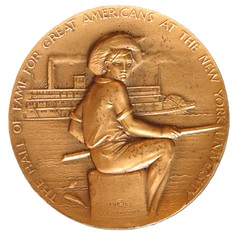 I am including a photo of one of the Hall of Fame medals. My justification for including the
medal is because I like it. I will not identify the topic but let readers speculate what it represents.
I am including a photo of one of the Hall of Fame medals. My justification for including the
medal is because I like it. I will not identify the topic but let readers speculate what it represents.
Listed above are three groups of coins and medals with something in common to the groups. I suspect there are hundreds of additional American authors on thousands of medals. When expanded to world authors in all languages the list would be huge.
Watch for future articles on related topics.
To read the earlier E-Sylum article, see:
NOTES FROM E-SYLUM READERS: AUGUST 3, 2025 :
Authors, Books or Libraries on Coins, Etc.
(https://www.coinbooks.org/v28/esylum_v28n31a12.html)
TREASURE TALK WITH BOB EVANS, EPISODE 7.1
In January, our good friend Bob Evans began publishing a series of blog articles on the Finest Known website detailing his experience as co-discoverer and curator of the treasures recovered from the wreck of the S.S. Central America. Subject of the book "Ship of Gold", many exhibits, countless interviews and articles, books and auction catalogs feature the legendary haul of gold coins, bars, nuggets, gold dust and more from the 1857 shipwreck. Here's another excerpt - see the complete article online. -Editor
Individual coins, ingots, nuggets and artifacts also created special moments during my decades of involvement with the S.S. Central America. I would like to share one of those stories.
In the previous expeditions, over two decades earlier, our gold recoveries were exclusively from the area where we found the commercial shipment. So, except for a minor amount of possibly intermingled passenger gold, the treasure we recovered 1988 – 1991 represented the money of banking and big business, shipped in large amounts on the twice monthly mail steamers to Panama, and then on toward New York.
In 2014, our recoveries from the coin piles we found in the debris field brought much more variety to the numismatic inventory of the SSCA. This was not the money of the businesses; this was the money of the businesspeople, the money of the wealthy street, the money that a businessman or a miner might like to have at hand for the expenses of a triumphant trip back east to "The States." So, instead of the boxes of double eagles we found in the commercial shipment, we found dozens of gold dollars, quarter-eagles, half-eagles, and eagles, strewn together in distinct groupings, small and large, or sometimes buried within heavier debris.
In the early expeditions, 1988 – 1991, we recovered over 7500 gold coins, but only three $3 gold pieces, all 1856-S. They were unusual, quite possibly representing passenger gold that had intermingled with the commercial shipment during the shipwreck's 13-decades of collapsing.
They were just three little pieces of gold, oddities among the thousands.
The Redbook (A Guide Book of United States Coins – an industry standard) still states (2024 Edition,) "…the coin was never popular with the general public and saw very little circulation." The statement dates back for decades in the Redbook, expressing standard numismatic opinion. So I was never surprised that we found only three.
In 2014, the results of our excursions into the debris field of the SSCA shipwreck in 2014 suggest that this lack of popularity may not have been entirely true, at least in San Francisco in the summer of 1857. We found sixty-three $3 gold pieces in 2014, coming from multiple coin piles, with as many as an astonishing sixteen emerging from Coin Pile #2.
It seems, at least someone found three bucks to be a useful denomination in that time and place.
Although I was a novice at numismatics when the project began in the mid-80s, I now had 30 years of coin study under my hat. Even before the season began, I realized that the "small gold" discoveries might be significant. (I think of "small gold" as anything smaller than a $20 Double Eagle.) I had a mental list of target coins, since an abundance of small gold coinage could result from our exploration of the debris field, or from other passenger sources.
In the reference library I had at sea was a spiral-bound copy of the 2014 Redbook, (A Guide Book of United States Coins – an industry standard,) and in my MacBook I had a digital version of the Krause Publications Standard Catalog of World Coins. My copy was from 2009, a few years out of date on prices, but perfectly suited for identifying any 19th-century foreign coins we might find.
The targets I looked for included the obvious ultra-rarities, like the 1854-S $5 half eagle (only 268 made, only 3 known in 2014) and the almost equally rare1854-S $2.50 quarter eagle (only 246 made, but a few more known – sources say a dozen.) With the SSCA story behind them, such finds could be million-dollar coins, which were becoming more and more frequent. It was tantalizing to speculate about a scenario where one of these tiny rarities (not at all valued as a collectible at the time) could find its way into circulation, and into the purse of some miner or San Francisco businessman a mere three years after being made, and from there onto a steamship bound for New York in September of 1857.
Alas, we never found the fruition of such a fantasy. But I always looked for them, whenever I had a fresh-from-the-seabed half-eagle or quarter-eagle in hand.
But there were other targets. I looked at lustrous, exposed surfaces where the ubiquitous rust had flaked off the gold, places that hinted at very high grades and values, mindful that many marks and issues could be obscured beneath the rust and mineralization that coated all or parts of almost every coin. We wouldn't really know what we had until the curating was finished and everything was in its final state, graded and encapsulated. Everything I had learned from the recovery and curation of the early expeditions' fantastic finding of 7500 gold coins from the commercial shipment was now applied to the broader components of the treasure, from all over the shipwreck site. I had plenty of experience in spotting high-grade mint-state coins, having seen thousands of "before and after" examples.
Two other $3 pieces had come from the Port Coin Pot we had just previously examined from the same dive, recovered from a different part of the debris field. They were an 1856-S and an 1855-S. Nice coins no doubt, but they didn't immediately look like anything extraordinary.
But now we had a new group of coins, from a different pile. I checked the two $3 coins then in front of me, both of which showed fabulous flash and practically flawless surfaces. Yep! 1857-S. Both of them. I arranged them on the mat and pulled the exam glove tightly over my fingertips. Keenly aware that the five-gram wafers of gold on the table could be worth over $100,000 apiece, I wanted no mistakes. A loose glove was not going to mess this up! They were both wonderful coins. That was obvious. I picked up what I judged to be the better of the two.
We already had a photo of an 1857-S $3 for the spreadsheet file, so Neil didn't photograph these coins when they were fresh in the Coin Room. I regret that we did not get pictures of them before we put them away. It was not required by the system and the procedure, so we skipped it. But they were certainly special. My recollection is that there were areas of both coins, particularly in the fields, where the rust had already flaked off during the jostling of recovery. Exposed, flashy fields, between Liberty and the legend, and between the wreath and the rim, led to my extra caution. My observation is that rust spalls off unblemished mint-state gold very easily, and that was certainly the case here. On both coins there was thin rust over 60% to 70% of their surfaces, but it could not disguise the marvels that lay beneath.
In the Spring of 2018, the results were final. During the curating in the lab in California, the rust came off these coins easily. And the results, as expected, re-wrote the condition census for 1857-S $3.
The new FINEST KNOWN 1857-S $3 came from the SSCA, and it graded MS-67. The second coin graded MS-65, and would have been the finest known, had it not been eclipsed by its sister.
To read the complete article, see:
Treasure Talk: Episode 7 Part 1
An Individual Favorite
(https://finestknown.com/treasure-talk-episode-7-part-1an-individual-favorite/)
For the complete series, see:
Category Archives: Treasure Talk with Bob Evans
(https://finestknown.com/treasure-talk-with-bob-evans/)
To read the earlier E-Sylum article, see:
TREASURE TALK WITH BOB EVANS, EPISODE 1
(https://www.coinbooks.org/v28/esylum_v28n12a12.html)
TREASURE TALK WITH BOB EVANS, EPISODE 2.1
(https://www.coinbooks.org/v28/esylum_v28n13a17.html)
TREASURE TALK WITH BOB EVANS, EPISODE 2.2
(https://www.coinbooks.org/v28/esylum_v28n14a15.html)
TREASURE TALK WITH BOB EVANS, EPISODE 3.1
(https://www.coinbooks.org/v28/esylum_v28n15a16.html)
TREASURE TALK WITH BOB EVANS, EPISODE 3.2
(https://www.coinbooks.org/v28/esylum_v28n17a16.html)
TREASURE TALK WITH BOB EVANS, EPISODE 4.1
(https://www.coinbooks.org/v28/esylum_v28n18a13.html)
TREASURE TALK WITH BOB EVANS, EPISODE 4.2
(https://www.coinbooks.org/v28/esylum_v28n19a20.html)
TREASURE TALK WITH BOB EVANS, EPISODE 5.1
(https://www.coinbooks.org/v28/esylum_v28n22a13.html)
TREASURE TALK WITH BOB EVANS, EPISODE 5.2
(https://www.coinbooks.org/v28/esylum_v28n23a16.html)
TREASURE TALK WITH BOB EVANS, EPISODE 6.1
(https://www.coinbooks.org/v28/esylum_v28n27a14.html)
TREASURE TALK WITH BOB EVANS, EPISODE 6.2
(https://www.coinbooks.org/v28/esylum_v28n30a21.html)
THE SAN FRANCISCO MINT IN 1913
Researcher and author Roger Burdette has been working for years now finding, scanning and organizing U.S. Mint documents at the National Archives. He submitted this research article. Thanks! -Editor
A persistent problem in numismatic research is the scattered nature of documents relating to a specific subject. Normally, this requires careful examination of a dozen or more archival files of a general nature, i.e., "Letters Sent," "Miscellaneous Correspondence," "Branch Mint Letters," etc., before we can begin to assemble a complete description of the subject.
However, during a period of about a decade from 1910-1919 the Mint Bureau filed most documents by subject. Clerks used a 6-digit code to indicate a topic of the correspondence. Each new item on that topic was given the same code number and all were filed together.
This letter by the new Superintendent of the San Francisco Mint in 1913 is an example of the kinds of material currently being uncovered during digitization work at National Archives. In this instance we have a first-hand account of the condition of the mint facility and requests for improvements. An additional 30 pages of back-and-forth correspondence adds to our understanding of the circumstances surrounding coinage production at that time.
Currently, the files being scanned are organized by topic. This brings letters written over several years into one set of documents and might eventually help answer some of our questions. For example, a different file has early Mint sources of silver organized by origin and calendar quarter. These were made in 1914 from original documents.
A transcription and minimal formatting were used to save space.
[RG104 Entry 229 Box 300. 313296]
TREASURY DEPARTMENT
MINT OF THE UNITED STATES
SAN FRANCISCO, CAL.
November 12, 1913
Director of the Mint,
Washington, D. C.
Sir:
I am addressing you upon various matters which have come to my attention since assuming the Superintendency. Some of my recommendations will entail the spending of a considerable amount of money, but I feel that such expenditures are warranted by the existing conditions. I have discussed these matters at length with Dr. Dewey, and he will be able to explain anything that I may not have made clear. Two things have impressed themselves upon me: One, that every effort should be bent toward devising methods to protect the coin and bullion; the other, that the internal appearance of the Mint, especially the portion seen by the visitors, should be improved. I hope that after consideration, you will give me your ideas upon the various subjects.
Inquiry reveals the fact that my predecessor paid for this class of bullion without melting, the bars remaining unmelted until they were either run through the refinery or into ingots. Frequently months elapsed between the receipt and the melting. Judge Sweeny, on the contrary, insisted on the immediate melting of all deposits received by the Mint. The Selby bars, which weigh about 2,000 ounces, being for convenience, run into two bars, approximating one thousand ounces each. To avoid the second melting, a great number of these one thousand ounce bars were stored as certificate bars, and are now under seal in one of our vaults.
One thousand ounce certificate bars have many disadvantages. It is difficult to weigh them as closely as is required; they are very liable to abrasion, as from their size and weight it is hard to handle them without scraping on the iron trucks or other bars, and they differ greatly in appearance to the regulation size certificate bars.
While I shall insist upon the immediate melting of the Selby bars, I have directed that as far as possible they be run, on the first melting, into regulation four hundred ounce bars. In the meantime we will use the fine gold product of our refinery for ingots, when necessary, and for certificate bars when our stock of gold coin is replenished.
A most peculiar condition arose during the past few days. We received a deposit of Mexican dore bullion, the depositor requesting fine silver in payment for the silver contained in the deposit. In accordance with the depositor's request, we, on November 1, 1913, issued bars amounting to 44,695 fine ounces, leaving the Mint with only 10,000 ounces of fine silver on hand. In the meantime the Crocker National Bank delivered 100,000 pesos in Mexican silver coin at the Mint, asking that we purchase the same. Upon being informed that we were unable to purchase, the Bank requested that we return fine bars for the silver contained. This we were unable to do, owing to the small stock of silver on hand. The Bank withdrew the pesos in question and disposed of them on the outside.
I also desire to call your attention to the condition of our stock of subsidiary silver coin. Today we have on hand the following:
- Half dollars: $40,573.50
- Quar. dollars: 146,548.00
- Dimes: 27,636.34
Of the above dimes, $20,000.00 is reserved for the Assistant Treasurer of the United States in this city, he having notified us that he would before long call on us for that amount. We are in receipt of the 100,000 ounces fine silver purchased by you, making 110,000 fine ounces silver on hand, and we will receive from our refinery 50,000 fine ounces per month. You will see from these figures that it will be, to say the least, a very difficult matter for us to build up our stock of subsidiary silver coin, especially so if we are called upon to issue fine bars in the amounts requested during the past two weeks. It does not seem to me that we should ever be in a position where the question of coining one or two hundred thousand dollars in silver, or the payment of seventy five or a hundred thousand ounces of fine silver bars should embarrass us, and, in order to relieve us from the danger of such embarrassment, I request that you purchase for this Mint five hundred thousand ounces of fine silver.
I intend to run on purchased power until the first of January, when I hope to be able to operate the new plant. After one or two months operations on power from our own plant I will be able to decide whether it will be best to manufacture or to purchase the electric current required.
This matter is, I understand, under consideration at the present time. I hope that action will be taken as soon as possible.
Upon hearing from you some time ago in relation to the lighting of the outside of the Mint, I made it a point to personally inspect not only the outside lights, but the inner lighting system as well. Together with Mr. Hawkins, I made a very thorough inspection, and while I was prepared to find an inefficient system, I was surprised at the condition existing. The outside lights are attached to the building just below a ledge of stone which prevents the light being thrown upward, and leaves everything above the lamp shrouded in darkness. The lamps throw but little light on the sidewalk and in the garden, and the Mint in general presents a most gloomy appearance. From across the street the lamps look like small balls of light and no general illumination is apparent. In fact the light under the present system is confined to the small space immediately around the lamps, the space between the lamps being but dimly lighted. From Market Street, the main thoroughfare of San Francisco, no lights at all are visible, and the Mint property is to be noted only on account of its extreme darkness. From the Mint Mr. Hawkins and I visited the Post Office, and found conditions entirely different. The Post Office has lamps attached to the building and posts just on the inner edge of the sidewalk. With both kinds of lamps burning the Post Office property was very well lighted and presented a marked contrast to our institution. The comments of citizens and the newspaper articles on the inadequate lighting of the Mint are, I must say, justified. I believe steps should be taken to remedy the defect, and, as you are aware, this can only be done by installing a system of lamp posts that will diffuse light not only upon the sidewalk and garden, but upon the building as well.
In 1911 Judge Sweeny took steps to install an interior lighting system, being supplied with some $560.00 worth of material by the Supervising Architect's Department, the wiring to be done by the Mint electricians. Under Mr. Marshall, Assistant Superintendent of Machinery and Chief Electrician, the attic and portions of the top floor of the Mint were wired, and in these places the lighting is good. Mr. Leach, I am informed, considered the work unnecessary and ordered it discontinued. In other than the above mentioned places the lights are temporary in character, globes being carried on cords and draped over furniture, gas fixtures, furnaces, machinery, etc. Where the cords with the electric globes have not been run, light is furnished by flaring and smoking gas jets. In our trip through the building we found wax tapers a help, and in a number of the rooms, a necessity. It seems to me that the Mint should be wired so that any room or corridor could be flooded with light when desired. Of course that may never be necessary, but one would think that the storehouse for such a great quantity of coin and bullion should be equipped to meet the emergency.
The Chief Clerk's office was lighted by two chandeliers, six gas jets to each chandelier. My office had one chandelier of the same type, and it was rather amusing to see the watchmen endeavoring to light the offices. In mine he succeeded in getting one gas jet to burn. In the Chief Clerk's office he was a little more successful, finding, if I remember correctly, four of the gas jets in working order. I have had our electrician wire these two offices and have purchased and installed modern electric chandeliers. It may be that time will lessen my feeling for the responsibility for the immense treasure in my possession. Of that I cannot tell, but at present I desire to safeguard things in every possible way, and I think that light is one of the surest ways of doing so. Our small mechanical force has much to attend to and would not, in my judgment, be able to handle such a big job. Even if they should start on it, it would take at least a year and a half or two years before they could finish. Under the circumstances, I think it would be best to take the matter up with the proper authority, with a view to remedying the existing conditions as soon as possible.
I am informed by the Supervising Architect's office in this city that they have just completed the wiring of the Appraiser's Building, one of San Francisco's oldest structures, and I hope you will use your good offices to get similar work in the Mint.
The settlement just finished has shown the necessity for more vault space. We lost a number of days' work by being forced to move coin out of a vault so that we could count back into the same vault. We have a space that, with a little brick work, will make an ideal vault, and will not only guard against useless work in future settlements, but will help in our general operations as well. If provision can be made with the Supervising Architect's department to supply the door, we can attend to the balance of the work ourselves.
Dr. Dewey has advanced a suggestion that I think should be given serious consideration. It is his idea that a small tunnel be run directly under the outer edge of the three silver dollar storage vaults. This would enable the watchmen to patrol under the vaults at stated periods, and would absolutely prevent any tunneling with intent to rob the institution. The silver dollar vaults run back to the outer line of the building to Fifth Street, and fear of tunneling under the street to the vaults, has, I am informed, caused my predecessor great uneasiness. If such a thing were accomplished, it, under the present conditions, would not be discovered for years, as the seals of the vault doors will in all probability not be broken until either my death or my successor is appointed. The work would be expensive and might require a special appropriation by Congress, but I must confess that I am unable to see how the 61,395,000 standard silver dollars stored in these vaults can be rendered wholly safe from attack in any other way. Will you give this matter consideration with a view to placing it in the proper channel to secure relief.
I desire to call the attention of my superior officers in the Treasury Department to the condition of the watch in this Mint. This I can best do by giving the age, etc., of the various watchmen. Inasmuch as similar conditions no doubt exist in other Federal buildings, I feel that the matter is one that should be governed by Departmental policy rather than individual action. The list follows:
| Name | Age | Physical Condition | Mental Condition |
|---|---|---|---|
| Bickford, T.M. | 78 | Feeble | Dull - Slow |
| Cady, E.A. | 71 | One leg | Dull - Slow |
| Decker, W.H. | 68 | Very poor sight | Dull - Slow |
| Flint, A.J. | 73 | Feeble | Dull - Slow |
| Healy, T. | 75 | Excellent | Alert - Quick |
| Holse, D. | 71 | Feeble | Dull - Slow |
| McGowan, H.H. | 44 | Excellent | Alert - Quick |
| Miller, E.L. | 66 | Good | Alert - Quick |
| Murphy, D.J. | 36 | Excellent | Alert - Quick |
| Williams, W.H. | 65 | Excellent | Alert - Quick |
| Woodin, E. | 71 | Fair | Dull - Slow |
| Zeitz, F. | 45 | Excellent | Alert - Quick |
The greater portion of the furniture in the Superintendent's and Chief Clerk's offices is the original furniture that was supplied in 1874 when the Mint was first opened. I wish to bring these offices up to the standard of the other Government institutions in this city, and with that in view will, in the latter part of the fiscal year, if the state of our contingent appropriation warrants it, request you to approve such purchases of furniture as I may consider necessary.
Respectfully,
/s/ T. W. H. Shanahan,
Superintendent.
Some thorough work! Were the purchases approved? If so, I wonder what happened to the discarded old 1870s furniture.
I've got both legs and good eyesight, but at my age I guess I'd be headed for the Feeble/Dull - Slow categories. -Editor
NUMISMAGRAM MEDAL SELECTIONS: AUGUST 10, 2025
Numismagram's Jeremy Bostwick sent along these four medals from his most recent upload of new material to his site. For all of the new items, please visit https://www.numismagram.com/inventory. -Garrett
103260 | GERMANY. Kölner Dom (Cologne Cathedral) bronze Medal. Issued 1855. Most Remarkable Edifices of Europe series (59mm, 83.31 g, 12h). By Jacques Wiener in Brussels and struck at the Geerts mint in Ixelles. DER DOM ZU KÖLN IN SEINER ZUKÜNFTIGEN VOLLENDUNG / UNSERE HOFFNUNG, perspective view of the cathedral exterior from the south-southeast, highlighting its ubiquitous single northern tower; in four lines in exergue: GESTOCHEN VON J. WIENER / NACH DEM VOM DOMBAUMEISTER E. F. ZWIRNER / ERGÄNZTEN BAUPLANE / VERLAG VON F. C. EISEN IN KÖLN // JUBELFEIER AM 14 AUG: 1848 DER ERSTEN GRUNDSTEINLEGUNG DES DOMES ZU KÖLN AM 14 AUG: 1248, perspective view of the cathedral exterior from the south-southeast; an additional four years of construction (since Wiener's previous take on this edifice) has taken place and is depicted in a completed south transept façade and additional clerestory-level structure over the nave; in seven lines in exergue, EINWEIHUNG DES HOHEN CHORS AM 27 SEPT: 1322 / OFT UNTERBROCHENER FORTBAU BIS ETWA 1500 / GÄNZLICHER STILLSTAND BIS ZUR ZWEITEN / GRUNDSTEINLEGUNG AM 4 SEPT: 1842 / DURCH FRIEDRICH WILHELM IV / KÖNIG VON PREUSSEN / 1855. Edge: Plain. Ross M151; van Hoydonck 124; Reinecke 27. Gem Mint State. Extremely glossy and brilliant in the fields, with astounding eye appeal. A wondrous representative from the always-popular series, and for this edifice for which there are a number of versions conveying the various states of construction over two decades. $565.
To read the complete item description, see:
103260 | GERMANY. Kölner Dom (Cologne Cathedral) bronze Medal.
(https://www.numismagram.com/product-page/103260)
103232 | FRANCE & SOUTH AFRICA. Paris International Expo bronze Award Medal. Issued 1900 as the official prize [awarded to George Rouillot] (63mm, 100.36 g, 12h). By Jules-Clément Chaplain at the Paris mint. REPUBLIQUE FRANÇAISE, bust of Marianne right, wearing oak wreath; oak tree to the left; cityscape of Paris in the background to right // EXPOSITION UNIVERSELLE INTERNATIONALE, Victory flying left, with head upturned to the right, holding a wreath and palm frond, and bearing victor, holding a torch, upon her back; view of the expo hall in the background; in exergue, cartouche with "G. ROUILLOT / PRÉSIDENT DE / LA CHAMBRE DES MINES" embossed in three lines. Edge: «cornucopia» BRONZE. Button 29; Wurzbach 7193. Choice Mint State. Tan-brown surfaces, with a great matte nature. $325.
To read the complete item description, see:
103232 | FRANCE & SOUTH AFRICA. Paris International Expo bronze Award Medal.
(https://www.numismagram.com/product-page/103232)
103230 | BOHEMIA. Praha (Prague) Chamber of Commerce and Industry bronze award Plaque. Issued 1908 (64mm x 89mm, 163.76 g, 12h). By Antonín Mára & Ivan Bojislav Pichl in Praha. Draped female standing left, holding wreath and with head turned away toward background veduta in bas relief panel // Upper body of Mercury left, reaching to artisan facing right; all in bas relief panel; in 11 lines below, JUBILEJNÍVÝSTAVA OBVODU / OBCHODNÍ A ŽIVNOSTENSKE / KOMORY PRAŽKE / SVÝM ÚCASTNÍKUM / A SPOLUPRACOVNÍKUM / DIE JUBILÄUMS=AUSSTELLUNG / DES BEZIRKES DER PRAGER HANDEL=S / UND GEWERBEKAMMER / IHREN TEILNEHMERN / UND MITARBEITERN / 1908 (jubilee exhibition of the Prague Chamber of Commerce and Trade District to its participants and collaborators). Edge: Plain. Hauser 3868; Wurzbach 7685. Choice Mint State. Olive-brown surfaces, with some alluring red highlighting the devices and with a great matte nature overall. Includes original box of issue. $225.
To read the complete item description, see:
103230 | BOHEMIA. Praha (Prague) Chamber of Commerce and Industry bronze award Plaque.
(https://www.numismagram.com/product-page/103230)
103231 | HUNGARY. Bull and Bear Markets bronze Medal. Issued 1923 (63mm, 112.37 g, 12h). By Szántó Gergely. • HAUSSE • • 1923 •, head of portly man facing slightly left, with mischievous grin and clasping hands in sense of greedy eagerness // • BAISSE •, head of thinner man facing slightly right, with furrowed brow and grabbing at head with both hands. Edge: Plain. Choice Mint State. Olive-brown surfaces. A rare and interesting satirical issue that illustrates the two aspects of the stock market in the years leading up to the crash and subsequent Great Depression. $295.
To read the complete item description, see:
103231 | HUNGARY. Bull and Bear Markets bronze Medal.
(https://www.numismagram.com/product-page/103231)
HERITAGE AUCTIONS: BYZANTINE COINS SHOWCASE
Heritage Auctions will be hosting their Byzantine Ancient Coins Showcase Auction on August 11. Select items are discussed below. -Garrett
Justinian II, First Reign (AD 685-695). AV solidus (19mm, 4.46 gm, 7h). NGC MS 4/5 - 2/5, brushed, marks. Constantinople, uncertain officina, AD 692-695. IhS CRIS?OS R?X-R??NAN?I?M, half-length bust of Christ facing, with long hair and full beard, wearing pallium and colobium, cross behind head, raising right hand in benediction, book of Gospels cradled in left arm / D I?STINI-AN-?S SER? CHRIS?I, full-length figure of Justinian II standing facing, wearing crown and loros, cross potent on two steps in right hand, akakia in left; CONO-P below. Sear 1248.
To read the complete item description, see:
Justinian II, First Reign (AD 685-695). AV solidus (19mm, 4.46 gm, 7h). NGC MS 4/5 - 2/5, brushed, marks.
(https://coins.ha.com/itm/ancients/byzantine/byzantine-justinian-ii-first-reign-ad-685-695-av-solidus-19mm-446-gm-7h-ngc-ms-4-5-2-5-brushed-marks/a/61528-23079.s)
Andronicus I Comnenus (AD 1183-1185). AV hyperpyron (31mm, 4.42 gm, 5h). NGC MS 3/5 - 4/5, edge crimp, die shift. Constantinople. Full-length figure of the Virgin seated facing on throne, holding nimbate head of infant Christ on lap; barred MHP-TV across fields / AN?PONIKOC-??C?OTHC, figures of Andronicus I (on left) and Christ (on right) standing facing, the former wearing crown with pendilia and loros with eight pellets on sleeve, labarum in right hand, globus cruciger in left, and being crowned by the latter, wearing nimbus cruciger and colobium, book of Gospels cradled on left arm; barred IC between, barred XC to right. Sear 1983.
Ex Heritage Auctions, Auction 61237 (21 November 2021), lot 99176.
To read the complete item description, see:
Andronicus I Comnenus (AD 1183-1185). AV hyperpyron (31mm, 4.42 gm, 5h). NGC MS 3/5 - 4/5, edge crimp, die shift.
(https://coins.ha.com/itm/ancients/byzantine/byzantine-andronicus-i-comnenus-ad-1183-1185-av-hyperpyron-31mm-442-gm-5h-ngc-ms-3-5-4-5-edge-crimp-die/a/61528-23119.s)
Irene, Sole Reign (AD 797-802). AV solidus (20mm, 4.42 gm, 6h). NGC MS 3/5 - 4/5. Constantinople. ?IRIhH-bASILISSH, bust of Irene facing, wearing loros and crown with pendilia, two pinnacles, and cross in center, globus cruciger in right hand, transverse cruciform scepter in left / •-?IRIhH-bASILISSH T, bust of Irene facing, wearing loros and crown with pendilia, two pinnacles, and cross in center, globus cruciger in right hand, transverse cruciform scepter in left. Sear 1599.
To read the complete item description, see:
Irene, Sole Reign (AD 797-802). AV solidus (20mm, 4.42 gm, 6h). NGC MS 3/5 - 4/5.
(https://coins.ha.com/itm/ancients/byzantine/byzantine-irene-sole-reign-ad-797-802-av-solidus-20mm-442-gm-6h-ngc-ms-3-5-4-5/a/61528-23090.s)
Constantine IV Pogonatus (AD 668-685). AV solidus (20mm, 4.53 gm, 5h). NGC Choice MS 4/5 - 5/5. Constantinople, 6th officina, AD 669-674. d N COS-T-N?S P, cuirassed bust of Constantine IV facing with short beard, turned slightly right, wearing crested helmet with frontal plume, spear in right hand over shoulder, shield decorated with horseman motif in left / VICTOR-I-A-V?? S, standing figures of Heraclius (on left) and Tiberius (on right), both beardless and wearing chlamys, globus cruciger in right hand; flanking central cross potent with base on three steps, CONOB below. Sear 1156.
Ex Heritage Auctions, Auction 61237 (21 November 2021), lot 99128.
To read the complete item description, see:
Constantine IV Pogonatus (AD 668-685). AV solidus (20mm, 4.53 gm, 5h). NGC Choice MS 4/5 - 5/5.
(https://coins.ha.com/itm/ancients/byzantine/byzantine-constantine-iv-pogonatus-ad-668-685-av-solidus-20mm-453-gm-5h-ngc-choice-ms-4-5-5-5/a/61528-23075.s)
Constantine VII Porphyrogenitus and Romanus I Lecapenus (AD 945-963). AR miliaresion (24mm, 1h). NGC Choice VF, marks. Constantinople. IhS?S XRI-St?S nICA, cross potent set upon three steps, crowned facing bust of Romanus in central medallion; R/O - m/A across fields, pelleted cross below, all in triple-border with four equally spaced globules / + ROMAnO' / COnSTAnT' / ST?FAnOS' / C? COnSTA' / ?n XO ?' R', legend in five lines, pelleted cross above and below, all in triple-border with eight equally spaced globules. Sear 1755.
To read the complete item description, see:
Constantine VII Porphyrogenitus and Romanus I Lecapenus (AD 945-963). AR miliaresion (24mm, 1h). NGC Choice VF, marks.
(https://coins.ha.com/itm/ancients/byzantine/byzantine-constantine-vii-porphyrogenitus-and-romanus-i-lecapenus-ad-945-963-ar-miliaresion-24mm-1h-ngc-choice/a/61528-23095.s)
Basil I the Macedonian and Constantine (AD 868-879). AV solidus (19mm, 4.40 gm, 7h). NGC Choice AU 5/5 - 4/5. Constantinople, AD 870-871. + IhS XPS R?X-R?GNANtI?M *, full-length figure of Christ enthroned facing, wearing nimbus cruciger, pallium, and colobium, right hand raised in benediction, book of Gospels cradled in left arm / bASILIOS ?T COhStAht' A??? b', facing busts of Basil I (on left), with short beard, wearing loros and crown surmounted by cross, and Constantine (on right), beardless, wearing chlamys and crown surmounted by cross, jointly holding patriarchal cross with globule at base between them. Sear 1704.
Ex Gemini, Auction IX (8 January 2021), lot 550; Calgary Coin, private sale with old dealer's tag included.
To read the complete item description, see:
Basil I the Macedonian and Constantine (AD 868-879). AV solidus (19mm, 4.40 gm, 7h). NGC Choice AU 5/5 - 4/5.
(https://coins.ha.com/itm/ancients/byzantine/byzantine-basil-i-the-macedonian-and-constantine-ad-868-879-av-solidus-19mm-440-gm-7h-ngc-choice-au-5-5-4-/a/61528-23093.s)
GADOURY BLEU: ISLAM, POPES, GOLD AND FRANCE
Gadoury's annual floor auction will take place on 3 and 4 October 2025. The material is presented in two catalogues. The blue catalogue showcases four collections with Islamic, French and papal coinage. Lovers of antiquity and Casa Savoia will also find fascinating pieces. -Garrett
Islam, Popes, Gold and France: Four Collections at Gadoury Bleu
3 October 2025
Gadoury Auctions
Monaco, Hôtel Le Méridien
Gadoury Auctions has established two auction series in recent years: the blue catalogue features collections, while the black one presents numismatic highlights from antiquity to the present day, sourced from various collectors.
In 2025, the blue catalogue contains four top-class collections. The sale begins with an extensive collection of Islamic coinage from the estate of Monsieur R. This is followed by papal issues from the Monsieur M. F. Collection. Monsieur J.'s interests included several areas, such as ancient coins – Greek, Roman and Byzantine – papal coins and issues of Casa Savoia. The auction concludes with the M. S. Collection featuring French issues.
The day begins with an extensive and fascinating collection of coins from the Islamic world. The focus is on gold coins, and the time frame ranges from issues of the Umayyads to early Moroccan francs. Almost all individual lots were graded by NGC. Most coins have estimates in the mid three-digit range. However, connoisseurs will discover many rarities of particular historical significance. For instance, there is a previously unpublished dinar that combines two different dies. One side dates from the era of Abd al Malik, i.e. from the years between 685 and 705. The other side dates from the time of Al-Walîd (705-715). This coin is of particular interest due to its iconographic similarity to Byzantine issues: rather than the cross on three steps that can be found on Byzantine coinage, the piece features a sphere on a staff.


Lot 8: Umayyads. Abd al Malik ben Marwén / Al-Walîd. Dinar-Solidus, Ifrîqiya, 86 AH / 705. Unpublished! NGC UNC DETAILS. Estimate: 1,500 euros. Diameter: 10 mm
One focal point of the collection containing about 566 lots is Arab rule in Spain. The earliest piece is connected to the Umayyad conquest of the country. The last pieces were minted under the Nasrid rulers of Granada. We highlight a Maravedi or Morabetino minted in the style of the Almoravids, created under Alfonso VIII, King of Castile and León. This coin transports us to the heart of the battles of the Reconquista: Alfonso emerged victorious from the Battle of Las Navas de Tolosa on 16 July 1212.


Lot 437: Castile and León. Alfonso VIII. Maravedi or Morabetino in the style of Almoravid dinars created at the same time, Toledo, 1247 of Safar (1209). NGC MS61. Very rare. Extremely fine. Estimate: 3,000 euros. Diameter: 26 mm
A great rarity of modern Moroccan numismatics is a gold coin from 1201 / 1796, commissioned by the Alawite ruler Sidi Muhammad III, who is now known as the "architect of modern Morocco". Not only did he conclude numerous trade agreements with European nations, he also planned a new currency. The order was issued on 13 January 1787, and the production began in Madrid on 22 September. 10,000 gold pieces and an unknown number of silver patters were minted. But these coins never entered circulation as the delivery reached Morocco after Muhammad III's death. His son Yazid did not share his father's admiration for Western models. Most coins were melted down. However, a few specimens have survived. Gadoury has the pleasure of offering both the gold and the silver coin as part of the Monsieur R. Collection.


Lot 481: Morocco. Sidi Muhammad III ben abd-Allah (2nd reign). 10 Misqual or Rial in gold, 1201 AH / 1796, Madrid. NGC AU53. Extremely rare. Very fine +. Estimate: 8,000 euros. Diameter: 24.7 mm


Lot 473: Morocco. Sidi Muhammad III ben abd-Allah (2nd reign). Dirham 1201 AH / 1796, Madrid. NGC PF61. Estimate: 2,000 euros. Diameter: 19.9 mm
The collection of papal coins of Monsieur M. F. contains more than 80 lots. All of them are characterised by their excellent condition and the variety of their reverses, making these coins a popular souvenir for travellers to Rome as early as in the 17th and 18th centuries. Our specimen from 1699 depicts the port of Anzio. It was built to promote the economic development of the surrounding area.


Lot 602: Papal States. Innocent XII. Piastra, Rome, year VIII, 1699. Port of Anzio. Rare. Extremely fine. Estimate: 2,500 euros. Diameter: 44 mm
Rome attracts a particularly large number of pilgrims when a Holy Year is announced and the Holy Door opened. This door is depicted on a piaster by Clement XI from 1700.


Lot 605: Papal States. Clement XI. Piastra, Rome, year I, 1700. Holy Door. Extremely fine. Estimate: 2,500 euros. Diameter: 44 mm
Coins depicting famous buildings of Rome have always been particularly popular. This specimen presents the church of Saint Theodore, built at the end of the 6th century, which was renovated and given an architectural frame by Pope Clement XI through Carlo Fontana. The courtyard, which was designed at the time, is clearly visible in front of the round church from late antiquity.


Lot 608: Papal States. Clement XI. Piastra, Rome, year III, 1703. Church of Saint Theodore in Rome. Beautiful patina. Extremely fine. Estimate: 1,000 euros. Diameter: 46 mm
A collector does not necessarily have to limit himself to one area. Monsieur J., who created the third collection featured in the blue Gadoury catalogue, did not. He bought pieces he liked, and many of them come with original Émile Bourgey bags, used to deliver coins to successful bidders – an indication of their provenance. The collection begins with a small but impressive selection of Greek gold coins.
The focus is on Roman coins, with a wide range of gold pieces in average, but also in extraordinary condition. It is a typical mixed collection as they were common to assemble a few decades ago. The collector was primarily interested in the historical significance of the coins. He was particularly drawn to sestertii with beautiful patinas, some of which are included in the auction sale.
The ensemble is completed by a selection of world coins, both in silver and mostly gold, as well as an extensive collection of French coins. Of the 117 lots, the majority are gold coins. Connoisseurs will also find numerous medieval rarities of the finest style.
The auction concludes with about one hundred lots of French coins, most of which are made of gold. This time, the time frame ranges from the late Middle Ages to the Napoleonic period. Once again, experts will spot numerous very rare pieces of historical significance. Notable examples include a florin d'or, minted when the popes withdrew to Avignon. Another highlight is an extremely attractive mouton d'or by Jean II le Bon, struck in the year before he was imprisoned.


Lot 919: Dauphiné / Viennois. Etienne II de la Garde, papal legate and Archbishop of Arles. Florin d'or, undated (1351-1361), Arles. Extremely fine. Estimate: 1,000 euros. Diameter: 20 mm


Lot 922: France. Jean II le Bon. Mouton d'or, 1355. About FDC. Estimate: 2,000 euros. Diameter: 30 mm


Lot 940: France. Louis XIII. Double Louis d'or, Paris, 1640 A, without berries. About extremely fine. Estimate: 5,000 euros. Diameter: 30 mm
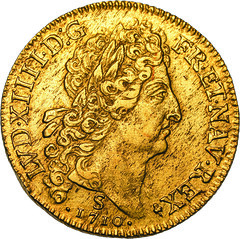

Lot 942. France. Louis XIV, Double Louis d'or au soleil, Reims, 1710 S. Rare. Very fine +. Estimate: 5,000 euros. Diameter: 30 mm
Please also take a look at our second auction preview with rare individual pieces from all over the world, from antiquity up to the 20th century.
You can order the catalogue at Gadoury Auctions, 57, rue Grimaldi, 98000 Monaco; phone: +377 93 25 12 96; fax: +377 93 50 13 39; email: contact@gadoury.com.
You can find the catalogue online at auction.gadoury.com, www.sixbid.com and www.numisbids.com. Of course, it is also possible to bid live on your computer at home via www.biddr.ch!
ABOUT THIS ISSUE: AUGUST 10, 2025
Another busy week, although Monday, not so much. I met my family at a local restaurant for a nice dinner after work. It was near a movie theater, and though no one else was interested in a movie I reserved myself a seat for The Naked Gun. The casting of Liam Neesen and Pamela Anderson was brilliant. It was uneven but thoroughly silly and often very funny. Not everyone will get the in-jokes and references to the earlier Leslie Nielson efforts, and even I missed Priscilla Presley's cameo. But it was plenty good enough entertainment for an evening. I enjoyed the little things they threw in everywhere, like the professional wrestling match at the "Ponzi-scheme.com Arena" with an NPR logo on the mat.
Numismatically I spent more time than usual on The E-Sylum as we worked on the move to MailChimp. I moved the mailing list over and dealt with various errors and exceptions; then Bruce and I worked on updating all the links to the subscription management pages. Let us know if you encounter any problems.
I also worked on plans for the upcoming ANA convention, including business for a sister organization, the Numismatic Literary Guild. I hope to see a number of our readers at the show in Oklahoma City.
I'll end with this question from comedian Rita Rudner: "How come when you mix water and flour together you get glue...and then you add eggs and sugar and you get cake? Where does the glue go?" -Editor
Wayne Homren
Wayne Homren is the founding editor of The E-Sylum and a consultant for the Newman Numismatic Portal. His collecting interests at various times included U.S. Encased Postage Stamps, merchant counterstamps, Pittsburgh Obsolete paper money, Civil War tokens and scrip, Carnegie Hero Medals, charge coins and numismatic literature. He also collects and has given presentations on the work of Money Artist J.S.G. Boggs. In the non-numismatic world he's worked in artificial intelligence, data science, and as a Program Manager for the U.S. Department of Defense.
Garrett Ziss
Garrett Ziss is a numismatic collector and researcher, with a focus on American paper money and early U.S. silver and copper coins. He is also a part-time U.S. coin cataloger for Heritage Auctions. Garrett assists Editor Wayne Homren by editing and formatting a selection of articles and images each week. When he's not engaged in numismatics, Garrett is pursuing a Master's Degree in Quantitative Economics at the University of Pittsburgh.
Pete Smith
Numismatic researcher and author Pete Smith of Minnesota has written about early American coppers, Vermont coinage, numismatic literature, tokens and medals, the history of the U.S. Mint and much more. Author of American Numismatic Biographies, he contributes original articles to The E-Sylum often highlighting interesting figures in American numismatic history.
Greg Bennick
Greg Bennick (www.gregbennick.com) is a keynote speaker and long time coin collector with a focus on major mint error coins and US counterstamps. He is on the board of both CONECA and TAMS and enjoys having in-depth conversations with prominent numismatists from all areas of the hobby. Have ideas for other interviewees? Contact him anytime on the web or via instagram
@minterrors.
John Nebel
Numismatist, photographer, and ANS Board member and Fellow John Nebel of Boulder, CO helped the ANA and other clubs like NBS get online in the early days of the internet, hosting websites gratis through his Computer Systems Design Co. To this day he hosts some 50 ANA member club sites along with our
coinbooks.org site, making the club and our E-Sylum archive available to collectors and researchers worldwide.
Bruce Perdue
Encased coinage collector (encasedcoins.info) Bruce Perdue of Aurora, Illinois has been the volunteer NBS webmaster from its early days and works each week to add the latest E-Sylum issue to our archive and send out the email announcement.

